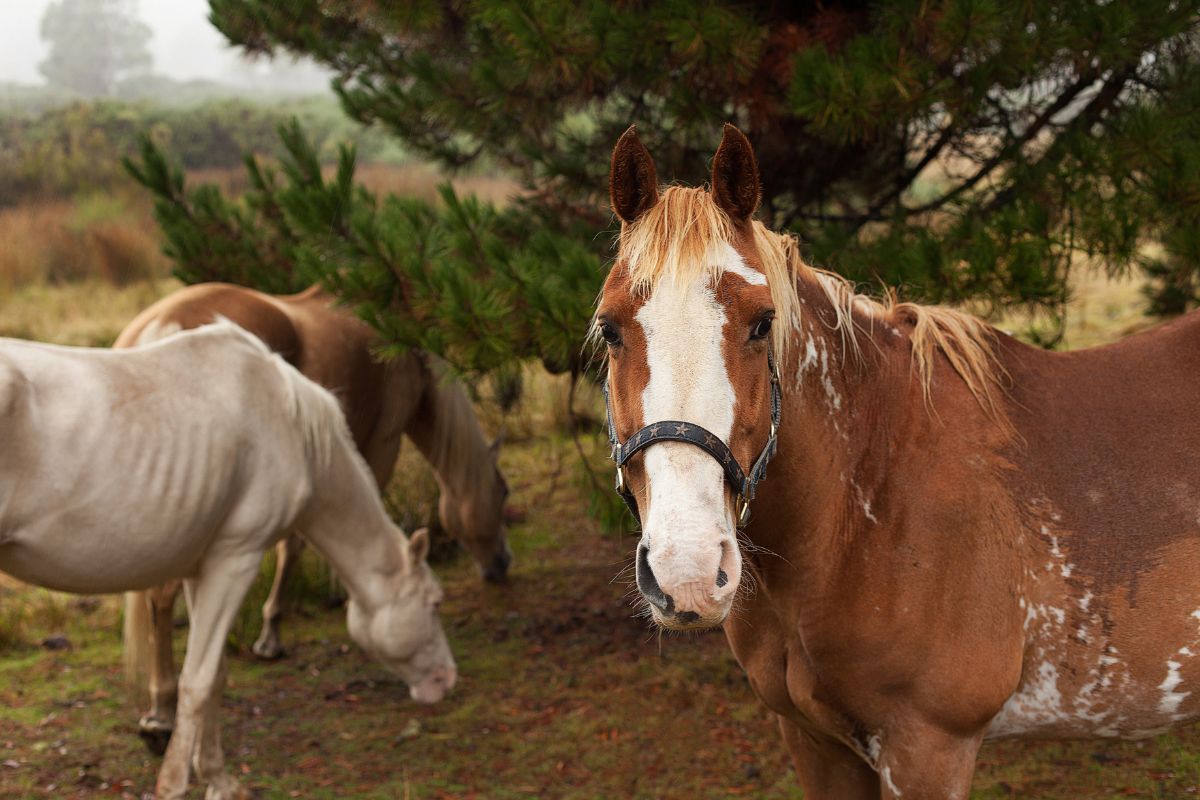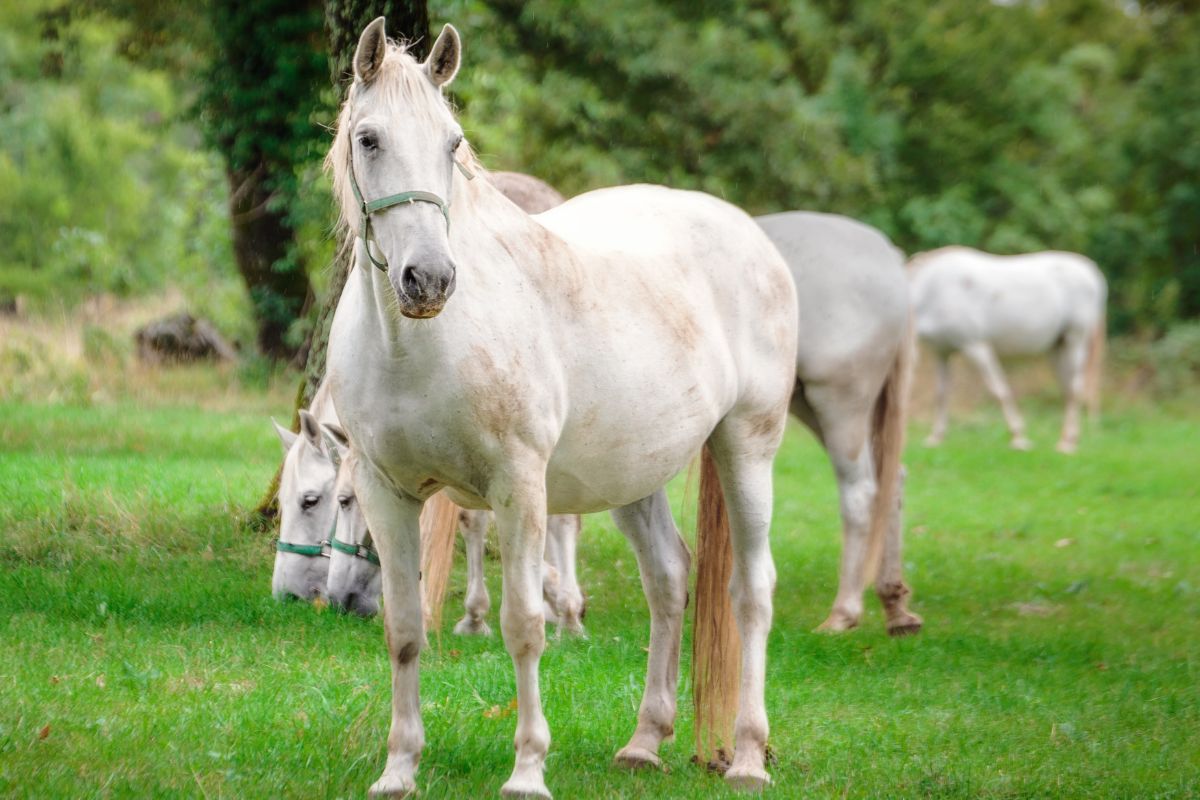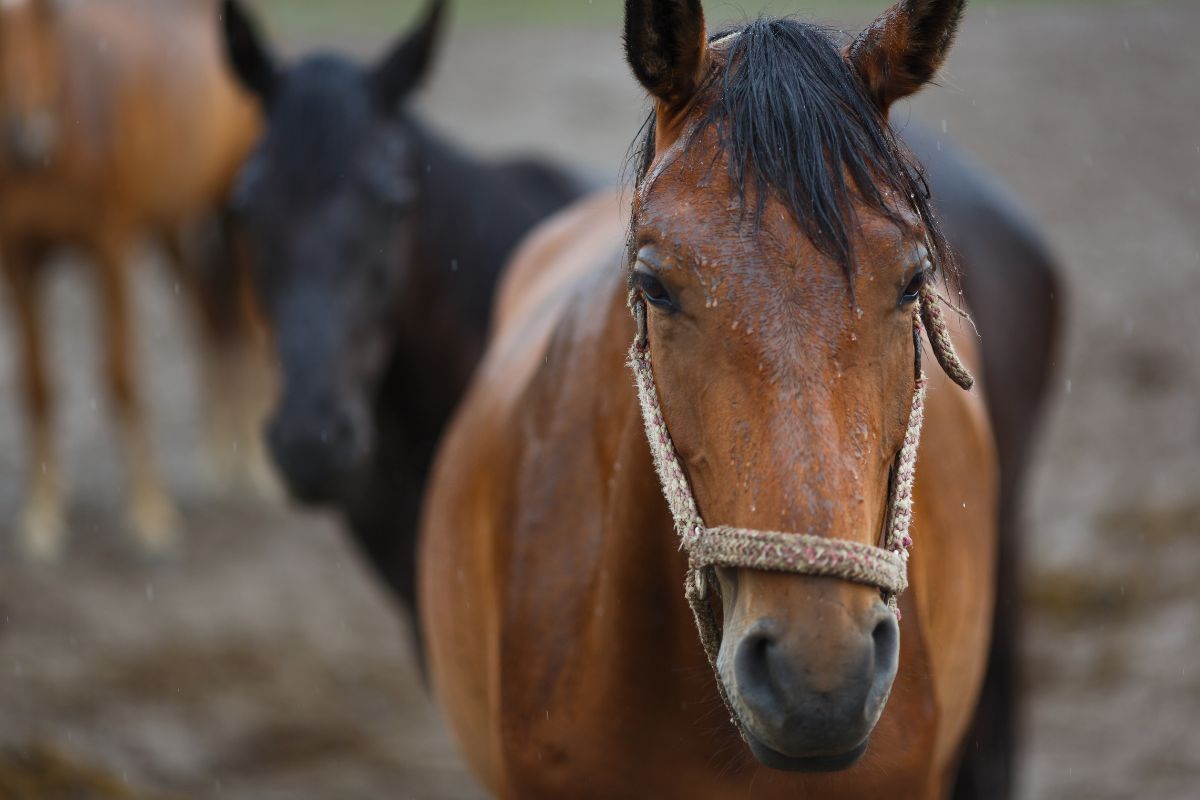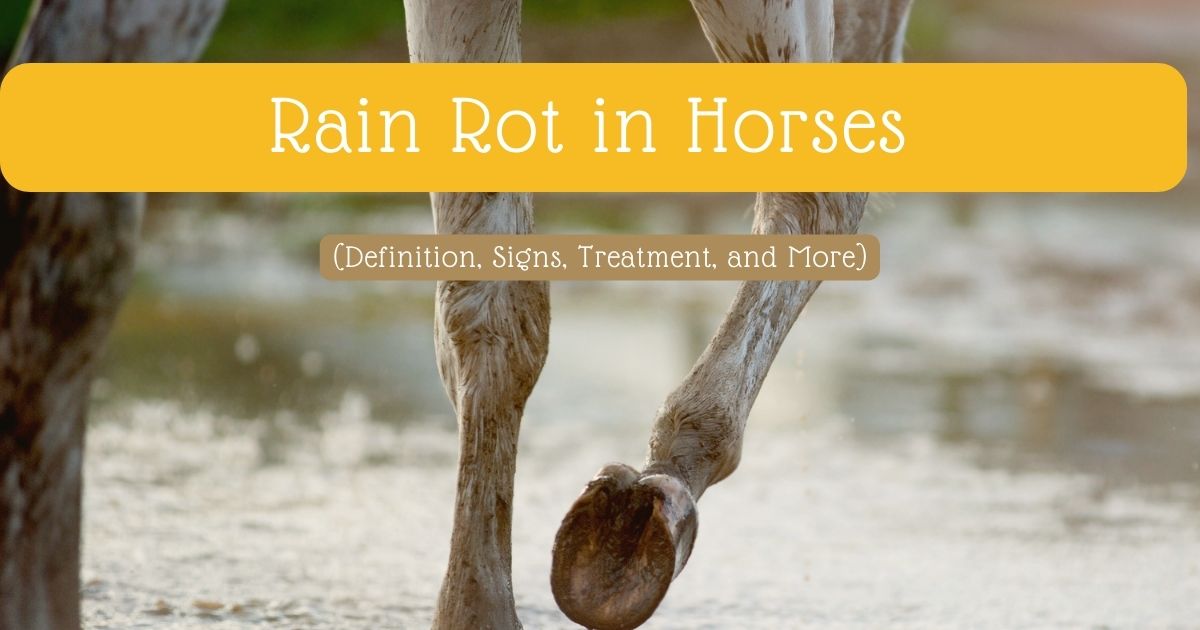The Definition of Rain Rot in Horses
What is rain rot in horses? Rain Rot in horses occurs when a horse’s skin barrier becomes compromised, and a bacterium known as Dermatophilus congolensis infects the skin.
Dermatophilus congolensis horse infections may remain dormant until wet and humid weather conditions or high insect burdens affect the integrity of the skin’s natural defense mechanisms.

What are the Causes of Equine Rain Rot?
Many owners wonder what causes rain rot in horses. Surprisingly, mild rain rot in horses occurs in even the best-managed stable yards.
Dermatophilosis mainly occurs in immunocompromised animals such as young foals, geriatric horses, and pregnant or postpartum mares that endure long periods of exposure to wet or humid weather.
The bacteria has filamentous hyphae that branch out, fragment into smaller round cells, and then mature into zoospores. The zoospores spread the infection from one animal to another.
Biting insects, contaminated stable equipment and surfaces act as carriers for the zoospore until they transfer onto a host and settle into their living epidermal layer. The bacteria lie dormant on asymptomatic carriers and only create a problem when it gains entry into the deeper dermal layers after climatic conditions become wet and crack the skin or the skin is injured.
Climatic conditions such as prolonged rainfall, high humidity levels, and high temperatures provide the ideal environment for the bacteria to proliferate. Midges, mosquitoes, and biting flies also increase the risk of infection into the deeper dermal layers.
The zoospores of D. congolensis enter the skin at compromised sites, where they then germinate and develop hyphae that penetrate the epidermis and spread. The hyphae produce an inflammatory reaction that damages the dermal layer, resulting in the cornified epithelium that forms a scab.
Horses can spontaneously heal if they mount an adequate immune response, and the condition becomes self-limiting after two to three weeks.
Chronically infected horses act as carriers with scabs and hair follicles that spread the bacterium from one affected area to the next. Wet scabs provide the ideal environment for zoospore growth and dissemination.
Some studies link specific horse coat colors with higher incidences of rain rot. Light-coated horses showed a higher incidence of infection compared to darker-coated horses.
How Do You Treat Rain Rot In Horses?
The treatment for rain rot depends on the severity of the infection as well as the immune status of the horse.
The following recommendations apply to the treatment of rain rot:
- Topical antimicrobial shampoo application helps to soften the scabs and remove them. Removing the scab disrupts the proliferation of zoospores and prevents the further spread of the bacteria. Chlorhexidine or benzoyl peroxide are good examples of effective medicated shampoos. So, lather the horse up and allow the shampoo to soak for ten minutes before rinsing. Next, dispose of any scabs in a closed container. Lastly, apply povidone-iodine to stubborn crusts.
- Grooming practices such as currying and brushing promote healing and help remove the scabs. Take care during grooming, as the scabbed-over areas are sensitive.
- Limit exposure to environmental factors such as rain and biting insects.
- Apply insecticides to unaffected areas to repel biting insects.
- Keep your horse dry during treatment.
- Isolate any infected animals from healthy animals to avoid spreading the bacteria.
If the infection is severe, a veterinarian needs to assess the degree of illness and possibly start the horse on antibiotic therapy. Generalized infections occur more often during prolonged periods of wet weather.
Once the weather dries up, the skin lesions in acutely infected animals heal quickly without complications or scars. Animals with severe generalized infections can lose weight and condition, suffer from lameness, or become infected with secondary bacterial strains that cause more severe dermatitis. Fly strike is also a concern if owners neglect the lesions.
Rain rot in horses home remedies may include treating the affected areas with aloe vera and restricting the skin’s moisture by applying coconut oil, petroleum jelly, or zinc oxide cream to the scabs.
Is Rain Rot in Horses Contagious?
Rain rot is highly contagious. Horse-to-horse contamination occurs when infected animals shed zoospores into the environment, and other horses come into contact with those spores.
The transmission also occurs when fomites such as grooming equipment, blankets, tack, and saddle pads. Biting insects also act as transmission vectors between horses and other animals, such as sheep, goats, and cattle.
Humans are also at risk of becoming infected with horse rain rot.
Rain rot in livestock causes significant economic losses due to morbidity and mortalities that affect the production of wool, milk, leather, and reproduction.
In drier climates, the zoospores remain unreleased and stay dormant in scabs for over 12 months until moisture triggers their release. Most infections remain localized in the skin, but in some livestock, the disease can enter the lymph nodes, muscles, and subcutaneous tissues, which is very painful.
Dermatophilosis treatment in livestock is ineffective because the topical and systemic antibiotics fail to reach the deep epidermis and avascular epidermal layers.
Humans show signs of self-limiting infections that resolve independently without treatment but may recur if the skin remains moist for ten or more hours a day. Antibiotics used to treat the condition include penicillin, ampicillin, streptomycin, amikacin, neomycin, erythromycin, tetracycline, chloramphenicol, sulfonamides, and norfloxacin.
There is a significant risk to immunocompromised individuals as they may encounter considerable complications if a generalized infection occurs and the immune system cannot clear it. Pregnant women, people with autoimmune disorders, and those with immunodeficiency viruses must exercise extreme caution when working with animals infected with D. congolensis.
What Does Rain Rot Look Like on a Horse?
The following signs accompany the lesions of rain rot; horses begin with small mats of hair that resemble a paintbrush. These areas become crusted and scab over and then progress to form multiple, coalescing mats of wart-like skin lesions—the inflammatory reaction results in a thick green or yellow-tinged exudate that sits underneath the scab.
Horses with short summer coats do not have matting; large areas of hair loss in a paintbrush pattern occur.
The stages of lesion formation include:
- Stage 1: Matting of hair in a paintbrush lesion.
- Stage 2: Coalesced lesions formation from crusting and scabbing.
- Stage 3: Wart-like lesions that flake off.

Can Humans Get Rain Rot From Horses?
Direct contact with infected animals or contaminated environments leads to bacterial infections of the hands and arms. The contagiousness poses a zoonotic risk, so owners, stable employees, and vets must wear gloves when working with or treating affected animals.
Stable yards should implement strict operation protocols to ensure no staff or additional animals become infected.
Where Does Rain Rot Appear on Equines?
Areas with white hair show a higher susceptibility to rain scald, especially on the pasterns, the lips, and the nose. The most commonly affected areas include the dorsal surface of the horse or the top line. Most lesions occur on the back, neck, face, and nose.
Rain rot on horses’ legs may result in lameness.
Common Myths Busted on Rain Rot in Horses
Owners Can Resolve Rain Rot by Peeling Off Scabs With Rigorous Grooming
Busted: Resolving rain rot requires a medicated shampoo, topical antimicrobial ointments, and external parasite control. The scabs leave the underlying skin layer vulnerable.
Treatment must remove the bacteria to avoid the spread of rain rot and restore good skin barrier health. The skin barrier has protective oils and a balanced pH that prevents excess moisture.
Grooming an infected horse requires additional precautions to avoid spreading the bacteria through the grooming tools and avoiding zoonotic infection. Remember to wear gloves and dispose of all organic material removed.
The Best Treatment for Rain Rot is Applying Insecticide Spray to the Horse’s Coat
Busted: Rain rot spreads through biting insects, so spraying an insecticide to help decrease the parasite burden will only prevent further spread; it will not cure the rain rot. Antimicrobials destroy the bacteria, which is the cause of the infection.
Many topical antimicrobial options treat rain rot, but the best options are medicated shampoos and povidone-iodine.
Rain Rot is not Similar to Dew Poisoning
Busted: D. congolensis causes both rain rot and dew poisoning. The name differs according to the location of the lesions. Dew poisoning refers to dermatophylosis of the pastern of the horse’s leg, whereas rain rot mainly occurs on the neck, head, and back.
Rain Rot Will not Become a Serious Condition if Left Untreated
Busted: Some immunocompromised horses risk developing generalized dermatophylosis, which can result in a severe loss of condition and vulnerability to secondary bacterial infection. It is also a welfare concern to leave a horse untreated as the lesions are painful and will leave a horse with significant discomfort for an extended period.
The sooner owners treat the scabs and remove the bacteria causing the condition, the sooner the horse will recover.
Staphylococcal folliculitis is a secondary infection agent that causes significantly more severe skin conditions that lead to pain, fever, and depressed appetites. It is vital to monitor horses with rain rot closely to ensure their situation does not escalate.
Rain Rot is Only a Problem in Some Parts of the Country
Busted: The bacteria that causes rain rot is found almost everywhere, but it takes a combination of climatic conditions, husbandry practices, and immune status to create the perfect environment for rain rot to become a problem in a stable.
All stable yard managers or owners must make a concerted effort to anticipate and manage conditions predisposing horses to rain rot.
Ensure the winter coats are clipped and groomed regularly and that blanket practices have a high standard of hygiene and compliance.
Grooming Practices to Prevent Horse Rain Rot
Grooming is a crucial part of horse ownership. The practice is not only about hygiene and good health; it is also a big part of bonding and enrichment for a horse. Grooming plays a big role in a horse’s health and welfare. Pat Parelli once said, “A horse doesn’t care how much you know until he knows how much you care.”
Owners should groom horses at least once a week or before each ride if a horse is stabled alone or not kept in a herd, as this keeps them comfortable and provides them with the attention and physical contact they would otherwise share with other horses.
Overgrooming is a problem as it strips the coat of natural oils, thereby removing its waterproofing capabilities, so it’s crucial to find a balance.
Horses that share paddocks and spend time together outdoors will show signs of allogrooming (mutual grooming), brushing up on trees, or rolling on the ground. These behaviors may spread the rain rot bacteria, so it is essential to quarantine horses with the condition to avoid more horses becoming infected.
A horse grooming kit needs to include the following items:
- Curry comb – Short-toothed comb made of rubber that loosens hair dirt and organic materials from the coat.
- Dandy brush – This hard-bristled brush removes the debris removed by the curry comb. Only use this brush on the horse’s body, not the mane and legs.
- Body brush – This soft-bristled brush soothes a horse and smooths the coat to allow the natural oils to come to the surface – This brush’s application onto the horse’s entire body helps spread the oils evenly.
- Metal curry comb – Used to clean either brush.
- Stable rubber – This is a grooming towel made of linen, terrycloth, or sheepskin that absorbs moisture when drying a horse.
- Sweat scraper – This rubber-bladed tool is excellent for removing sweat and moisture trapped under the coat after a ride or a bath respectively.
- Insect repellant spray – Applying a spray to the horse’s coat is essential as it will help prevent biting insects that may spread rain rot between horses.
How to Disinfect Grooming Equipment
After working with horses infected with rain rot, sterilizing grooming tools is very important. Cleaning the equipment is critical to avoid spreading the bacteria or reinfecting the horse.
Listed below are a few pointers to help clean grooming tools:
- Use dishwashing gloves to wash the tools and avoid spreading the bacteria to your skin.
- Curry combs contain a lot of debris and organic matter, including dirt and scabs, after the horse gets brushed down. Use a large plastic bucket to collect the debris and a metal curry comb to brush off the dirt, or just bang the comb on the side of the bucket to loosen any matted hair and grime.
- Groomers must also brush out body and dandy brushes with a metal curry comb to remove any organic build-up.
- Prepare another bucket or a tack box with warm water and a chlorhexidine solution to soak the brushes in before deep cleaning them. Baking soda is also a great option to apply to the brush and its bristles as it releases many oils and organic matter, making it easier to clean.
- After soaking the brushes, rinse them thoroughly with warm water and place them somewhere to dry. Place the brushes facing down or on their side to help preserve the longevity of the brush handle, especially if it’s wooden.
- After the brushes undergo an excellent wash, ensure you dispose of the water contaminated with the scabs, organic debris, and soap down a drain to avoid environmental contamination with zoospores.
How to Disinfect Horse Blankets Contaminated with Rain Rot
Simply hosing down horse clothing with water and shampoo is not enough to rid the material of bacteria.
Disinfecting the material requires a good wash with warm or hot water, which can damage the waterproofing of fabrics used in most turn-out blankets. The harsh chemicals can also damage the material as well, so it is not advisable to use detergents that contain bleach, softeners, or brighteners.
Blanket washes must have formulations that clean the material without softening or brightening the fabric.
Turnout blankets have particular materials that need to be cared for with special detergents.
Other fabrics not used in turnout blankets can undergo cleaning with the following laundry disinfectants:
- Pine-oil disinfectants work well in any water temperature, but the product must have at least eighty percent pine oil to be effective. Some brands include Lysol Pine action and Pine-Sol.
- Phenol-containing disinfectants work well in hot or warm water. Lysol disinfectant is the most widely available option.
- Quaternary disinfectants are not commercially available and are most effective in all water temperatures. The product from Amway, known as Pursue, is specifically formulated for laundry and works well on laundry.
Can the Condition be Prevented?
If stable yards have a problem with rain rot, also known as rain scald, horses’ coats need close examination by owners and grooms to look for crusty scabs, bald spots, or easily exfoliated clumps of hair daily.
Good stable yard management decreases the risk of rain rot, but even the best-cared-for horses may develop the condition if exposed to prolonged wet weather. Restrict access to muddy areas to avoid mud caking and increased risks of skin complications.
Regular grooming and baths will ensure early detection. Additional efforts to dry horses or reduce their exposure to biting insects and wet weather limit the risk of developing rain scald.
Waterproof rugs, stabling, and adequate shelter help to keep horses dry in inclement weather. Ectoparasite protocols that decrease exposure to biting insects are essential to avoid skin irritations that lead to compromised dermal barriers.
Stable managers or owners must take preventative measures to ensure that affected horses undergo quarantine and that all grooming equipment and blankets used for the affected horses get sterilized before use.
As the bacteria multiply best in warm, wet conditions, keeping the horse stabled, sheltered, or rugged with a waterproof rug during damp weather protects the skin from prolonged wetting and helps to prevent infection.

The Bottom Line
Horse owners and stable managers must prepare for prolonged wet weather to ensure that horses do not experience unnecessary risk factors that may lead to the development of rain rot. Management must include mitigation of exposure to wet environments, parasite control, and regular inspection of horses’ health and coat condition.
Rain rot will affect a horse’s performance if the skin lesions are painful, so riders and owners lose valuable training or competing time. This common condition, although easy to treat, is inconvenient and highly contagious to other horses and humans.
D. congolensis is very serious if horses reside on a farm with other production animals that need good health. Significant economic implications for farming practices include milk production, leather, or wool as the quantity and quality of the product becomes severely hampered by dermatophylosis infections.
Immunocompromised humans and animals are also at a high risk of developing generalized infections that poorly affect their health and well-being. Stable managers and horse owners are responsible for the health and safety of their staff, riders, and horses.
